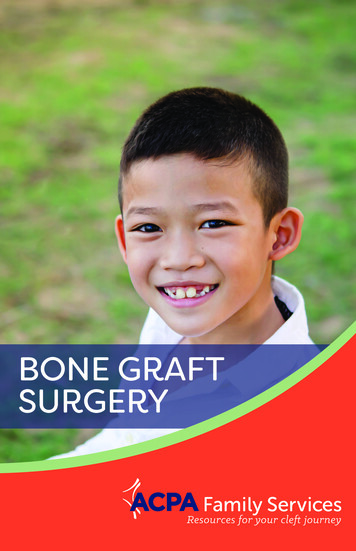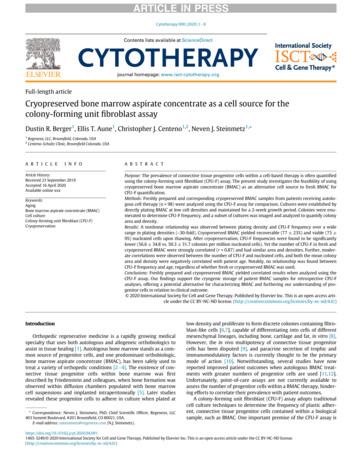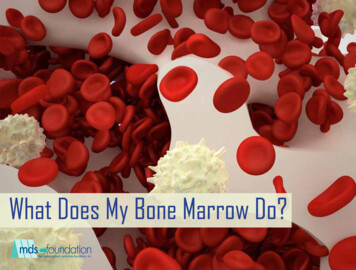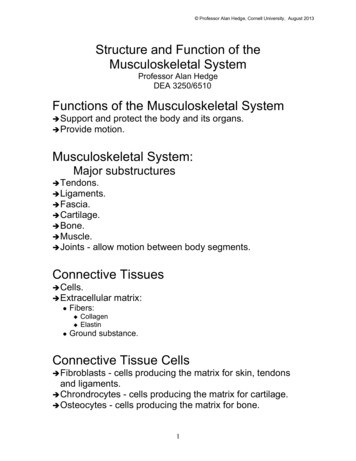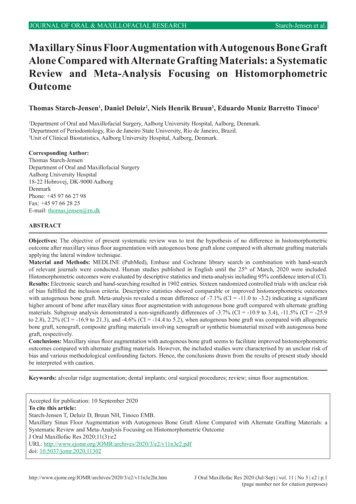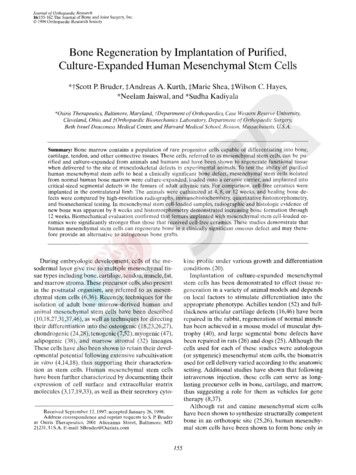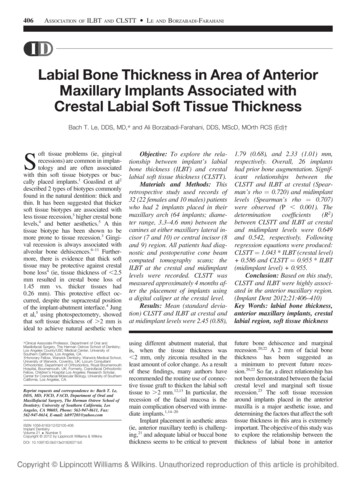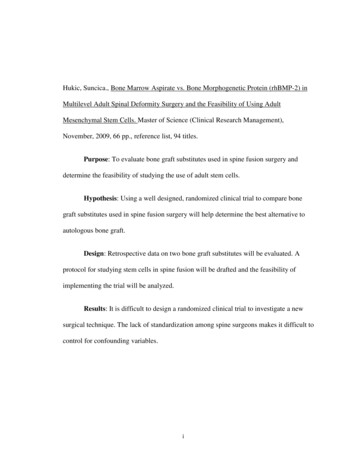
Transcription
Hukic, Suncica., Bone Marrow Aspirate vs. Bone Morphogenetic Protein (rhBMP-2) inMultilevel Adult Spinal Deformity Surgery and the Feasibility of Using AdultMesenchymal Stem Cells. Master of Science (Clinical Research Management),November, 2009, 66 pp., reference list, 94 titles.Purpose: To evaluate bone graft substitutes used in spine fusion surgery anddetermine the feasibility of studying the use of adult stem cells.Hypothesis: Using a well designed, randomized clinical trial to compare bonegraft substitutes used in spine fusion surgery will help determine the best alternative toautologous bone graft.Design: Retrospective data on two bone graft substitutes will be evaluated. Aprotocol for studying stem cells in spine fusion will be drafted and the feasibility ofimplementing the trial will be analyzed.Results: It is difficult to design a randomized clinical trial to investigate a newsurgical technique. The lack of standardization among spine surgeons makes it difficult tocontrol for confounding variables.i
BONE MARROW ASPIRATE VS. BONE MORPHOGENETIC PROTEIN (RHBMP-2) INMULTILEVEL ADULT SPINAL DEFORMITY SURGERY AND THE FEASIBILITY OFUSING ADULT MESENCHYMAL STEM CELLSINTERNSHIP PRACTICUM REPORTPresented to the Graduate Council of theGraduate School of Biological SciencesUniversity of North TexasHealth Science CenterIn Partial Fulfillment of the RequirementsFor the Degree ofMASTER OF SCIENCEBySuncica Hukic B.S.Fort Worth, TXNovember, 2009iii
ACKNOWLEDGEMENTSI wish to express my gratitude to Dr. Patricia Gwirtz for her guidance throughout mygraduate school career and her support and advice during my internship. I would like to thankDr. Reeves for his help and suggestions during my internship experience and for being my majorprofessor. I would also like to thank Nanette Myers and Chantelle Freeman for all of theirsupport, help, and for taking their time to act as my committee members. I am grateful for thewonderful and highly informative and educational experience I had at the Scoliosis ResearchCenter.iv
TABLE OF CONTENTSChapterPageI.INTRODUCTION 1II.INTERNSHIP SUBJECT 3Background and Literature Review 3Specific Aims and Hypothesis . 19Study Rationale .20Materials and Methods . 21Results and Discussion . 28Summary and Conclusion . 31III.INTERNSHIP EXPERIENCE .33Internship Site Activities .33Journal Summary . 34APPENDIX . . 36LIST OF REFERENCES . .53v
CHAPTER IINTRODUCTIONI conducted my internship at the Baylor Scoliosis Center located on the campus of BaylorRegional Medical Center at Plano, where I worked as a clinical research coordinator. The BaylorScoliosis Center’s clinical practice opened in 2005 as the first center in the Dallas/Fort Worthmetroplex devoted to the treatment, surgery, and care of advance spine curvature in adults. As anational referral center, the providers at the Baylor Scoliosis Center performed more than 400surgeries to straighten the spine of scoliosis patients in the last year. In addition to performingsurgical correction, the team at the Scoliosis Center offers its patients continuity of care with along-term treatment plan.In 2006, through the Baylor Research Institute, scoliosis research studies commenced at theBaylor Scoliosis Center. With the commitment to advanced research efforts, the research teamconsisting of two clinical research coordinators and one clinical research assistant, manages nineactive studies. Research in the areas of pain, spine fusion, genetics, possible scoliosisbiomarkers, surgical techniques, instrumentation, and surgical outcomes are being investigated.The main goal is to improve the treatment and quality of life of all spine deformity patients.Currently all of the ongoing studies are observational or review studies. During my internshipexperience I had the opportunity to participate, observe, and assist in various aspects related tothe management of clinical trials. At the start of my internship, I reviewed some of the available1
literature on scoliosis, its treatments, outcomes, and complications. I also reviewed the ScoliosisResearch Center study protocols and became familiar with the various clinical outcomes,questionnaires, and databases used for research purposes. I observed the research study processincluding patient consent, data collection, and follow-up. In addition, I assisted with thepreparation of various IRB documents and various other case report forms.As part of my internship, I was asked to assist in the drafting of the manuscript for one of thestudies that had just completed enrollment. The manuscript was based on a retrospectivecomparison analysis of Bone Marrow Aspirate (BMA) in combination with a carrier sponge(HEALOS ) versus Bone Morphogenetic Protein-2 in surgically treated scoliosis patients. Thehypothesis of this trial was that the two grafting alternatives were equivalent in fusion successand clinical outcomes.Based on extensive literature review and data from the HEALOS study, it became apparentthat scoliosis research was in need of more well designed, randomized clinical trials. Therefore,this study looked at the feasibility of implementing an investigational, randomized clinical trialusing adult Mesenchymal stem cells versus bone marrow aspirate in surgical arthrodesis. Idesigned an investigational study protocol and presented it to the Baylor Institutional ReviewBoard (IRB) for approval. Outcomes measures for this study were complications with design ofthe study and feedback from the IRB.2
CHAPTER IIINTERNSHIP SUBJECTBackground and Literature ReviewScoliosisScoliosis is a complex three-dimensional disease of the spine. The scoliotic spine has anabnormal side to side curvature and is also generally associated with a rotational deformity. It isfurther radiographically defined as a curve greater than or equal to ten degrees measured by theCobb method with rotation. Scoliosis can be found at birth, due to genetic causes, developedduring childhood, or developed late in life due to degenerative disc or joint disease (8). Theprevalence of scoliosis was estimated to range from 1.4 to 9 %. Girls are more likely to havescoliosis. The incidence is greater in the children of women with scoliosis and particularly in thedaughters of these women (16).Radiographic imaging is the main diagnostic tool. In particular, standardanterior/posterior (AP) and lateral full-length spine x-ray films are used to measure the Cobbangle (38). In addition, in patients with scoliosis, the shoulders or pelvis may not be level, orwaist asymmetry may be noted. Scoliosis may be suspected when one shoulder appears higher3
than the other or pelvic asymmetry is noted. In some cases, as the spine curves abnormally, theinvolved vertebrae are forced to rotate. If rotation occurs at the thoracic level of the spine,vertebral turning impacts the rib cage and may result in rib and scapular prominence. The ribhump, or prominent lumbar curve, can be accentuated by having the patient lean forward fromthe waist, permitting the arms to hang down; the examiner then views the spine. The rib humpcan be quantified by using a scoliometer, which permits measurement of angular deformity.The symptoms and physiology in adult patients with spinal deformity are more complexthan for childhood spinal deformity (9). Adult scoliosis can either be carried over from childhoodor develop de novo as a result of degenerative changes in the spine leading to deformity (16).Childhood scoliosis that progresses into adulthood may lead to many significant problems.Untreated scoliosis in the adult can lead to painful spinal osteoarthritis, progressive deformity,spinal stenosis with radiculopathy, muscle fatigue, and psychological effects of living with avisible deformity (16). This can be especially disabling in the older population and can impactdaily activities.Various methods have been used to treat scoliosis, including observation, bracing, andoperative treatments. Observation is usually reserved for patients who have curves less than 25degrees. Skeletally immature patients with curves less than 25 degrees should be examined every6 to 12 months. Skeletally immature patients with curves greater than 25 degrees generallyrequire bracing, which is used to stop curve progression rather than correct curves. Curvesgreater than 40 degrees are difficult to control with bracing and are at greater risk forprogression. One study found that 68% of patients had progression of their curvature afterskeletal maturity for curves greater than 50 degrees while curves less than 30 degrees tended notto progress (16). In growing children, operative treatment is indicated for severe deformity4
(curves greater than 50 degrees) that progressed despite bracing and uncontrolled pain. Inadolescents the decision for surgery is highly driven by the degree of deformity. Operativeconsiderations for spinal deformity in adults include: pain, functional limitation, neural elementcompression, degree and location of deformity, curve magnitude and deformity progression (16).While the incidence of complications in adolescent patients is quite low, the risk of majorcomplications in adult scoliosis surgery is reported to be upward of 30% with increased ratesfound in association with more complex cases, older patients, and patients with coexistingmedical conditions (37, 59).Spinal FusionSpinal fusion is a surgical method of treating severe scoliosis patients. The procedurestabilizes the spine by fusing adjacent vertebrae together, eliminating normal intervertebralmovement, and forming a solid mass of bone incorporating the adjacent vertebrae. Theprocedure alleviates the back pain caused by spine curvature and prevents further progression ofdeformity. The goals of surgery for spinal deformity are to correct or to improve deformity,minimize morbidity or pain, maximize postoperative clinical outcomes, prevent progression ofthe curve, and improve the function of the lumbar spine. Surgical approach may include anterior,posterior, or combined anterior and posterior fusion depending on a variety of factors (28, 32,35).The basics of spinal fusion involve the use of some type of fixation hardware to correctthe deformity and to hold the spinal bones together while placing graft material betweenvertebral bodies in the anterior column or in the posterior interlaminar region to act as a bridgeand scaffold for osteoblasts and to promote ingrowth of new bone. The hardware keeps the spine5
from moving while new bone forms to bridge the vertebrae. Most spinal instrumentationconstructs have two elements. The first element is a device that solidly attaches to the vertebralbodies, such as screws placed in the pedicles or vertebral bodies. The second element is a devicethat traverses the vertebral segments to be fused and locks to the screws. Screws are placed atmultiple selected sites along the deformity, and distraction or compression is applied to correctthe curve. Once biologic fusion occurs, the bones are permanently locked together and thehardware is no longer necessary. However, it is generally left in place to avoid another procedureto remove it (10, 90).The long-term success of any operative procedure for scoliosis depends on a solidarthrodesis, or fusion. The success of spinal fusion depends on surgical preparation of the fusionsite, systemic and local factors, ability of the graft material to stimulate a healing process, andbiomechanical features of the graft positioning. The surface of the bone and the facets should bedecorticated to provide a large, maximally exposed surface area for vascular ingrowth and toallow delivery and attachment of osteoprogenitor cells (48, 57). Fusion rates can range from 46%to almost 98% (11). These rates may increase with improvements in surgical techniques, bonegrafts, and hardware.It is not always obvious when a solid fusion has been obtained as opposed to a nonunionor pseudarthrosis (12). Accomplishment of fusion is defined radiographically by bridging oftrabecular bone connecting the two vertebral bodies, no angular motion in excess of five degrees,no sagittal translation in excess of three mm, and no radiolucencies that involve more than halfof the interface between the vertebral end plates (55, 56). Radiographs are accurate in assessingsuccess or failure to attain solid fusion only 70% of the time (60). Although surgical exploration6
remains the “gold standard” for definitive fusion success, CT scans are also an acceptablemethod (8).Pseudarthrosis (PSAR)Despite modern advanced techniques, achieving multilevel spinal fusion in adultdeformity patients continues to pose a significant challenge. The failure of arthrodesis, orpseudarthrosis (PSAR), is defined as the documented failure of solid fusion 1 year afteroperation (14). The rate of nonunion, or pseudarthrosis, for spinal fusion has been reported to bebetween 5% and 35% (14, 27). In adult patients, the pseudarthrosis rate is substantial especiallyif a long fusion is being attempted in patients older than the age of 55 years (27). Kim et alreported the overall prevalence of nonunion following long adult spinal deformity fusion withinstrumentation was 24% (55, 56). Failure to achieve solid fusion may lead to pain, loss ofcorrection, progression of deformity, instability, and potential neurologic injury (57, 84). Inaddition, a nonunion frequently leads to unsatisfactory resolution of clinical symptoms andusually results in greater medical costs due to the need for additional surgeries and increasedmorbidity (13).Factors contributing to pseudarthrosis include inadequate surgical technique, failure toneutralize excessive motion, or shear stresses at the segments to be fused (84). Implanting less ofthe normal volume of graft, absence of decortications in the host bed, and using inadequateinstrumentation may contribute to disappointing fusion rates (79). In addition, host-specificfactors such as age, gender, comorbidities, and smoking have been shown to affect the rate offusion. Length of fusion construct and poor local bone quality has also had negative impact onsurgical outcomes (57).7
Diagnosis of PSAR is based on clinical presentation and imaging studies. High suspicionfor PSAR may necessitate re-exploration and fusion (79). In general, criteria used to detectpseudarthrosis are: (1) loss of fixation, such as implant breakage, dislodgement of rods or hooks,or halo around pedicle screws; (2) progression of deformity with or without pain; (3) subsequentdisc space collapse; (4) motion during surgical exploration (56). In addition, patients with PSARscore significantly lower on quality of life index questionnaires (SRS and ODI). Overall, a highdegree of clinical suspicion along with CT scans may be the most reliable method for PSARdiagnosis (79).The management of pseudarthrosis in the adult scoliosis patient depends upon the level ofthe nonunion, the presence or absence of deformity, and the presence or absence of pain. Apainful pseudarthrosis associated with progressive deformity and loss of fixation is a clearindication for spinal revision surgery (16). Treatment of patients with symptomaticpseudarthrosis involves a second attempt at fusion and may require an approach different fromthat of the index surgery as well as the use of additional instrumentation, bone graft, andosteobiologic agents (79). Although asymptomatic pseudarthrosis are well documented,Steinmann and Herkowitz found pseudarthrosis to be the contributing factor in 78% of thosepatients requiring reoperation (84).Bone GraftThe majority of traumatized tissues heal with a fibrous scar. The cells and structure of thescar are not normal and are unable to fully assume the function of the tissue. In contrast, bone iscapable of true cellular, morphologic, and functional regeneration (27). Thus, bone is a uniquetissue because it is able to form normal bone following fracture and the disruption of its matrix.8
Bone regeneration is required to achieve spinal fusion. The initial phase of bone healing ischaracterized by an inflammatory response with the release of cytokines and various growthfactors (58). These proteins facilitate the proliferation of marrow stromal cells adjacent to thewound site as well as recruitment of undifferentiated mesenchymal stem cells (MSCs) fromnearby tissues. MSCs then proliferate and differentiate into osteoblasts (46, 52, 58). Matureosteoblasts secrete the type I collagen and non-collagenous proteins of the bone matrix andregulate the mineralization process of bone formation (82).Thus, the biological processes involved in bone regeneration require three criticalelements as follows: an osteogenic potential that is capable of directly providing cells to thenewly forming bone, osteoinductive factors that are able to cause osteoblastic differentiation ofosteoprogenitor stem cells, and osteoconductive scaffold that facilitates neovascularization andsupports the ingrowth of bone (66). For fusion to succeed, osteoprogenitor cells mustdifferentiate into osteoblasts, populate the fusion matrix, survive in the fusion environment, anddeposit bone.The choice of graft material will influence the outcome of a spinal fusion.Osteoconductive materials serve as nonviable, passive scaffolding to promote vascular invasionand a surface onto which osteogenic cells can attach for new bone formation (58). The threedimensional scaffolds play a critical role in both cell targeting and cell transplantation strategies.Scaffold matrices serve as space holders; provide surfaces that facilitate the attachment, survival,migration, proliferation, and differentiation of stem cells and progenitors; and provide a voidvolume in which vascularization, new tissue formation, and bone remodeling can occur (71, 73).In addition, an osteoconductive matrix provides a vehicle for the delivery of cells and proteinsinto the graft site (75).9
Osteoinductive materials are ones that provide biologic signals necessary to mediaterecruitment and differentiation of cell types essential to bone formation (39). Osteoinductivesubstances also induce differentiation of local mesenchymal stem cells (MSCs) into matureosteoblasts and promote neovascularization. Osteogenic materials are those that contain viableosteoprogenitor and osteoblast cells that can lay down new bone matrix. These bone-formingcells participate in the early stages of the healing process to unite the graft to the host bone (14).While osteoprogenitor cells and MSCs are capable of direct osteosynthesis, no osteoconductivematerial or osteoinductive stimulus will be effective in the absence of osteogenic cells (82).Osteogenic cells may be added to the surgical site or they may migrate into the graft site fromsurrounding tissues (70, 71). The ideal bone graft material posses all the three critical elements(osteoconduction, osteoinduction, and osteogenic potential). In patients undergoing spine fusion,the choice of bone-graft substitutes remains an emotional rather than scientifically drivendecision for many.AutograftAutogenous bone is considered the most successful bone graft material and is consideredthe “gold standard” of graft materials. An autograft is bone taken from one site, most commonlythe iliac crest, and transported to another site within the same individual. Advantages of autograftinclude immunogenetic compatibility, absence of disease transmission, and biomechanicalstrength (82). Inherent to this material are all three of the ideal transplant properties: osteogenicpotential, osteoinductivity, and osteoconductive.However, high rates of postoperative pain and morbidity often results from the graftingprocedure as well as limited fusion rates due to mechanical and biologic deficiencies of the10
donor bone. Complications with its use may occur in as many as 25-30% of patients and 10-40%of patients do not achieve a solid fusion (14, 81, 29). The morbidity of harvesting autograft hasbeen well documented and includes chronic donor-site pain, infection, neurologic injury, bloodloss, cosmetic deformity, bowel injury, vascular injury, hernia, and prolonged surgical andhospitalization time (27). Sasso et al reported persistent pain lasting at least 2 years after surgeryin 15-39% of patients (81).In addition, multilevel fusions often require substantial amounts of graft material and canexceed the available amounts in the iliac crest. Thus, the quantity of bone available to harvestmay be insufficient for a long, multisegmental fusion or in a patient with previous graft harvest.Instrumentation to the pelvis can also prohibit the extent to which the crest can be used withoutloss of fixation (27).Eliminating iliac crest bone graft harvest has the potential of decreased blood loss,decreased surgical time, and earlier hospital discharge, which, in combination with early, stablebone union and elimination of donor site comorbidity should result in better clinical outcomes. Asearch for a true autograft substitute has been an active area of research for at least 20 years.Multiple choices for graft alternatives have been introduced into the market. These graftalternatives have undergone varying degrees of regulatory scrutiny, however, none have level 1evidence to support their efficacy in adult scoliosis surgery (14).AllograftAllograft is the second most commonly transplanted tissue, secondary only to blood (47).Allograft is bone taken form a human cadaver and transplanted into the fusion site. Allograft isosteoconductive and may also be osteoinductive depending on its preparation (66). Allograft11
bone from cadaver donors requires meticulous attention to donor selection criteria. Acomprehensive sociomedical history must be obtained, the cause of death determined, andserologic and other laboratory testing performed. The bone has to be harvested under sterileconditions within the first 12-24 hours after death, cultured, and processed for preservation andstorage (14). Allograft is nearly unlimited in quantity, it saves operative time and cost associatedwith harvesting of autograft, and avoids donor site morbidity (27). In addition, allograft bonedoes not require human leukocyte antigen (HLA) cross-matching because most of the antigenicstimuli are removed during the processing, sterilization, and preservation procedures (27, 76,80). Immunogenicity and the maintenance of the osteoinductive and osteoconductive propertiesof the allograft bone are related to the method of graft processing and preservation (66).Disadvantages of allograft include the potential risks of bacterial contamination andpossible transmission of viral diseases such as those caused by the human immunodeficiencyvirus (HIV) and hepatitis virus (66). The rate of HIV transfer from allograft bone is estimated atless than 1 in 1 million (27, 90). In addition, the processing and sterilization procedures can leadto other changes in graft properties, such as loss of osteogenic properties, decreased mechanicalstrength, decreased osteoinductive potential, delayed time of fusion, and potential nonunion (14,82).Although there are many animal studies evaluating allograft, few clinical studies ofadequate design have been reported. Products considered to involve minimal manipulation ofcells or tissues are regulated as tissue rather than devices. As a result no standardized burden ofproof level for safety or effectiveness is required before these products are marketed and used inhuman patients (13, 17). In general, allograft has compared favorably with autogenous bone ininterbody fusions. Dodd et al and Aurori et al recommend using allograft in spinal interbody12
fusion surgery for scoliosis (36, 7). Both groups reported high fusion rates for allograft fusionwithout the morbidities associated with iliac crest bone graft harvest. However, results have notbeen reliable when allograft was used posteriorly, where it incorporated slower and lesscompletely with decreased vascularization in comparison to autograft (40). Jorgenson et al andAn et al concluded that allograft alone were not able to achieve a sufficient fusion rate forposterior spinal fusion in adult patients (5, 54). Therefore, allograft bone on its own is generallyunreliable for stimulating fusion without the contribution of added factors.Bone Marrow AspirateAside from autogenous bone graft, bone marrow is the only other readily available sourceof osteoprogenitor cells. Marrow is, in fact, the bioactive component of autograft and has beenregarded as a rich source of osteoprogenitor cells (87). The addition of bone marrow aspirate(BMA) has been shown to enhance the performance of a wide variety of bone graft materials(68, 73). The osteogenic potential of bone marrow used for grafting is dependent on the numberof viable osteogenic precursor cells, or Mesenchymal stem cells (MSCs), placed into theoperative site (87). Iliac crest bone marrow contains the highest percentage of osteogenic cells,and in a young patient, approximately 1 per 50,000 nucleated bone marrow cells is anosteoprogenitor cell (47). The marrow is harvested by needle aspiration from the patient’s pelvis,which is a relatively nonmorbid procedure (68). After harvest, the aspirate is combined with anosteoconductive material. The osteoconductive scaffold provides the framework for themigration and attachment of the MSCs and the environment necessary for the synthesis of theextracellular matrix (82). By adding MSCs to the osteoconductive scaffold the composite graftbecomes osteogenic, in effect providing a competitive alternative to autograft (39). Bonemarrow aspirate with HEALOS (DePuy Spine, Raynham, MA), a collagen-hydroxyapatite13
sponge (CHS), was approved by the Food and Drug Administration (FDA) in December 2001 asa bone graft substitute (4).In preclinical trials, Tay et al demonstrated that in posterolateral lumbar fusion (PLF), CHSsoaked in BMA produced fusion rates comparable with those produced by autologous graft (87).In human clinical trials, BMA on CHS used in single-level and multi-level posterolateral lumbarfusion showed no significant difference when compared to ICBG (10, 25, 39, 41, 74). Inmultilevel posterolateral lumbar fusion, Neen et al reported equivalent fusion rates for the twogroups, while BMA fusion was lower in lumbar interbody fusions, reporting a 20% fusion failure(74). Carter et al observed 95% fusion in multilevel TLIF/PLF when using BMA/CHS,concluding that BMA/CHA can be considered a bone graft substituted when used in TLIF/PLF(25). Studies have also confirmed the histological and mechanical properties of the fusion massproduced by BMA/CHS to be adequate for posterior fusion (10, 41). Therefore, deformitysurgeons have been using Bone Marrow Aspirate (BMA) combined with HEALOS , acollagen-hydroxyapatite sponge (CHS), in patients requiring fusion of multiple levels.Nevertheless, BMA use is challenged by a range of problems including inconsistent or lowconcentrations of endogenous osteoprogenitor cells. Muschler et al demonstrated the influence ofaspiration technique and volume on the concentration of MSCs. The study documented rapiddilution of MSCs by peripheral blood as aspiration volumes increased from one cc to four cc(68). Thus volume of the aspirate has been limited to less than 2 cc per site to reduce dilution. Inaddition, BMA may be less effective in patients who are experiencing a decline in theirmesenchymal stem cell repository as a result of age, systemic illness, or osteoporosis. Severalstudies have published data on the age-related decline in the number and activity of MSCs (72,82, 85). Moreover, due to the high degree of inter-individual variation in the osteoprogenitor cell14
concentration of bone marrow, the osteogenic capacity of BMA may vary (82). BMA containingless than 1000 MSCs/cc has been shown to be ineffective for arthrodesis although the optimalnumber of cells required in a graft site is not known (53). Therefore, fresh bone marrow that hasnot undergone any treatment or culturing may not be as effective at promoting osteogenesis.Several techniques have been developed to concentrate bone marrow derived MSCs.Different scaffolds have been developed with specific characteristics and biocapbilitites thatincrease MSC adherence. By decreasing the flow rate of bone marrow through the matrix, itssurface properties facilitate the rapid attachment of MSCs and removing red blood cells, serumand most other marrow components (69). This process could be carried out perioperatively anddoes not require expensive instrumentation. Another technique, cellular expansion of bonemarrow derived MSCs in vitro, effectively concentrates the cells through cellular engineering,producing unlimited numbers of MSCs (46). However, the procedure takes several weeks,requires two separate surgeries and sophisticated instrumentation, and is expensive. In addition,there are risks of contamination and mutations (58, 69). This procedure is not approved, has notbeen tested in humans, and does not seem to have much future potential.Bone Morphogenetic Protein (BMP)Dr. Marshall Urist discovered bone morphogenetic proteins in 1965 while observing thecapacity of demineralized bone to induce ectopic bone formation in a rat muscle pouch (93).Urist introduced the concept that bone growth factors can induce new bone formationindependent of the bone tissue environment. Subsequently, bone morphogenetic proteins (BMPs)were isolated from demineralized bone. To test for their osteoinductive potential, BMPs wereplaced beneath the skin of test animals to assay for bone formation (89).15
BMPs are found within the bone in small quantities. BMPs are part of the transforminggrowth factor β-superfamily (TGFβ) and have an important role in bone form
The Baylor Scoliosis Center's clinical practice opened in 2005 as the first center in the Dallas/Fort Worth metroplex devoted to the treatment, surgery, and care of advance spine curvature in adults. As a national referral center, the providers at the Baylor Scoliosis Center performed more than 400 surgeries to straighten the spine of .
